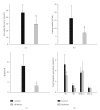Berberine Moderates Glucose and Lipid Metabolism through Multipathway Mechanism
- PMID: 20953398
- PMCID: PMC2952334
- DOI: 10.1155/2011/924851
Berberine Moderates Glucose and Lipid Metabolism through Multipathway Mechanism
Abstract
Berberine is known to improve glucose and lipid metabolism disorders, but the mechanism is still under investigation. In this paper, we explored the effects of berberine on the weight, glucose levels, lipid metabolism, and serum insulin of KKAy mice and investigated its possible glucose and lipid-regulating mechanism. We randomly divided KKAy mice into two groups: berberine group (treated with 250 mg/kg/d berberine) and control group. Fasting blood glucose (FBG), weight, total cholesterol (TC), triglyceride (TG), high-density lipoprotein-cholesterol (HDL-c), low-density lipoprotein-cholesterol (LDL-c), and fasting serum insulin were measured in both groups. The oral glucose tolerance test (OGTT) was performed. RT(2) PCR array gene expression analysis was performed using skeletal muscle of KKAy mice. Our data demonstrated that berberine significantly decreased FBG, area under the curve (AUC), fasting serum insulin (FINS), homeostasis model assessment insulin resistance (HOMA-IR) index, TC, and TG, compared with those of control group. RT(2) profiler PCR array analysis showed that berberine upregulated the expression of glucose transporter 4 (GLUT4), mitogen-activated protein kinase 14 (MAPK14), MAPK8(c-jun N-terminal kinase, JNK), peroxisome proliferator-activated receptor α (PPARα), uncoupling protein 2 (UCP2), and hepatic nuclear factor 4α(HNF4α), whereas it downregulated the expression of PPARγ, CCAAT/enhancer-binding protein (CEBP), PPARγ coactivator 1α(PGC 1α), and resistin. These results suggest that berberine moderates glucose and lipid metabolism through a multipathway mechanism that includes AMP-activated protein kinase-(AMPK-) p38 MAPK-GLUT4, JNK pathway, and PPARα pathway.
Figures





Similar articles
-
Berberine Inhibits Gluconeogenesis in Skeletal Muscles and Adipose Tissues in Streptozotocin-induced Diabetic Rats via LKB1-AMPK-TORC2 Signaling Pathway.Curr Med Sci. 2020 Jun;40(3):530-538. doi: 10.1007/s11596-020-2210-4. Epub 2020 Jul 17. Curr Med Sci. 2020. PMID: 32681256
-
Mixture of five herbal extracts ameliorates pioglitazone-induced aggravation of hepatic steatosis via activating the adiponectin receptor 2/AMP-activated protein kinase signal pathway in diabetic KKAy mice.J Tradit Chin Med. 2017 Oct;37(5):588-598. J Tradit Chin Med. 2017. PMID: 32188218
-
Flavonoids extracted from mulberry (Morus alba L.) leaf improve skeletal muscle mitochondrial function by activating AMPK in type 2 diabetes.J Ethnopharmacol. 2020 Feb 10;248:112326. doi: 10.1016/j.jep.2019.112326. Epub 2019 Oct 19. J Ethnopharmacol. 2020. PMID: 31639486
-
Effect of Korean Red Ginseng on metabolic syndrome.J Ginseng Res. 2021 May;45(3):380-389. doi: 10.1016/j.jgr.2020.11.002. Epub 2020 Nov 12. J Ginseng Res. 2021. PMID: 34025131 Free PMC article. Review.
-
An overview of the crosstalk between inflammatory processes and metabolic dysregulation during diabetic cardiomyopathy.Int J Cardiol. 2013 Oct 9;168(4):3160-72. doi: 10.1016/j.ijcard.2013.07.150. Epub 2013 Aug 6. Int J Cardiol. 2013. PMID: 23932046 Review.
Cited by
-
Antidiabetic Activity of Polysaccharides from Tuberous Root of Liriope spicata var. prolifera in KKAy Mice.Evid Based Complement Alternat Med. 2013;2013:349790. doi: 10.1155/2013/349790. Epub 2013 May 26. Evid Based Complement Alternat Med. 2013. PMID: 23762123 Free PMC article.
-
Different structures of berberine and five other protoberberine alkaloids that affect P-glycoprotein-mediated efflux capacity.Acta Pharmacol Sin. 2019 Jan;40(1):133-142. doi: 10.1038/s41401-018-0183-7. Epub 2018 Nov 15. Acta Pharmacol Sin. 2019. PMID: 30442987 Free PMC article.
-
Efficacy, safety and influencing factors of intra-calf muscular injection of bone marrow mononuclear cells in the treatment of type 2 diabetes mellitus-induced lower extremity vascular disease.Exp Ther Med. 2017 Nov;14(5):5177-5185. doi: 10.3892/etm.2017.5193. Epub 2017 Sep 22. Exp Ther Med. 2017. PMID: 29201234 Free PMC article.
-
Dose-response of berberine on hepatic cytochromes P450 mRNA expression and activities in mice.J Ethnopharmacol. 2011 Oct 31;138(1):111-8. doi: 10.1016/j.jep.2011.08.058. Epub 2011 Sep 6. J Ethnopharmacol. 2011. PMID: 21920422 Free PMC article.
-
Biologically active isoquinoline alkaloids covering 2014-2018.Med Res Rev. 2020 Nov;40(6):2212-2289. doi: 10.1002/med.21703. Epub 2020 Jul 29. Med Res Rev. 2020. PMID: 32729169 Free PMC article. Review.
References
-
- O’Brien RM, Granner DK. Regulation of gene expression by insulin. Physiological Reviews. 1996;76(4):1109–1161. - PubMed
-
- Kiberstis PA. A surfeit of suspects. Science. 2005;307(5708):p. 369.
-
- Ni YX. Therapeutic effect of berberine on 60 patients with type II diabetes mellitus and experimental research. Zhong Xi Yi Jie He Za Zhi. 1988;8(12):711–707. - PubMed
-
- Cicero AFG, Rovati LC, Setnikar I. Eulipidemic effects of berberine administered alone or in combination with other natural cholesterol-lowering agents: a single-blind clinical investigation. Arzneimittel-Forschung. 2007;57(1):26–30. - PubMed
LinkOut - more resources
Full Text Sources
Research Materials
Miscellaneous

